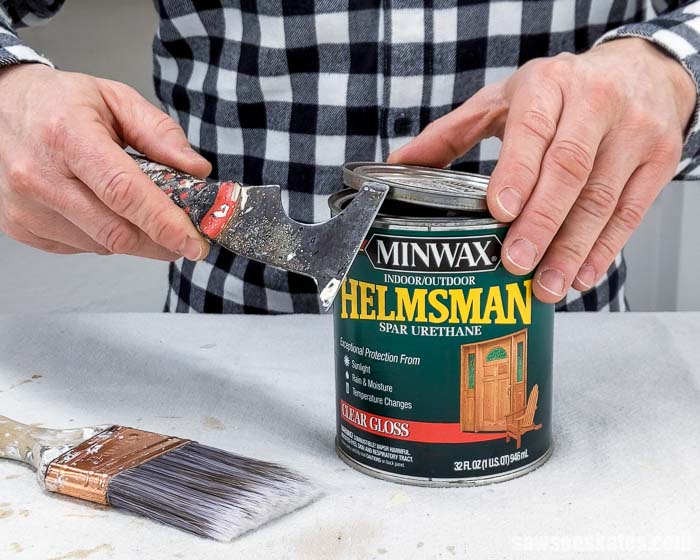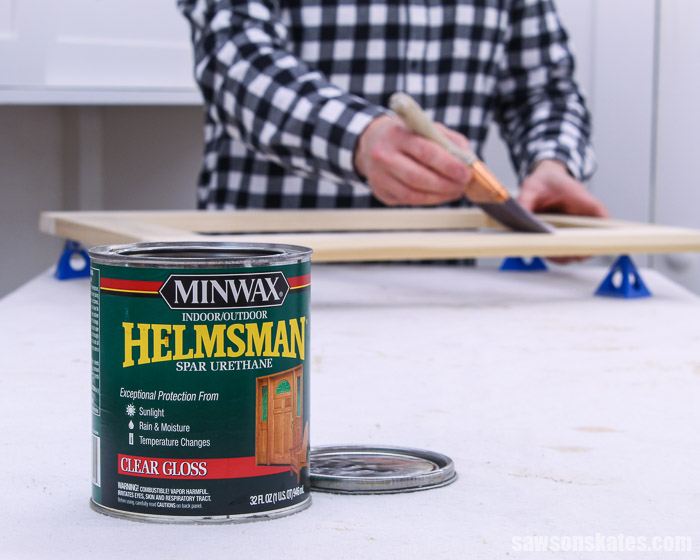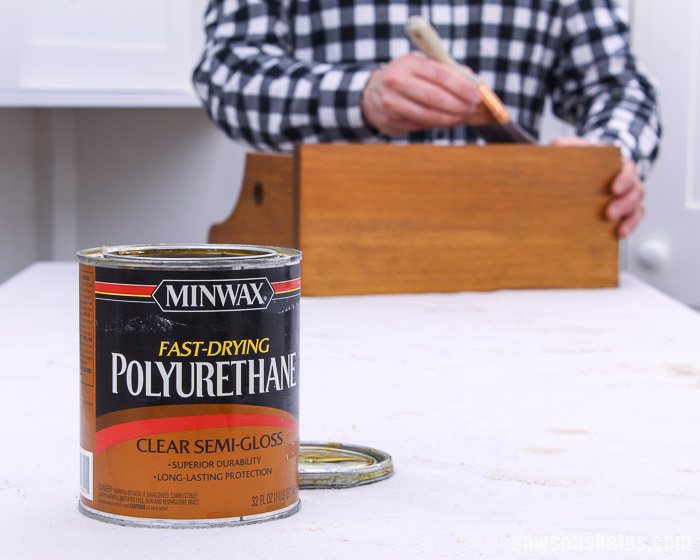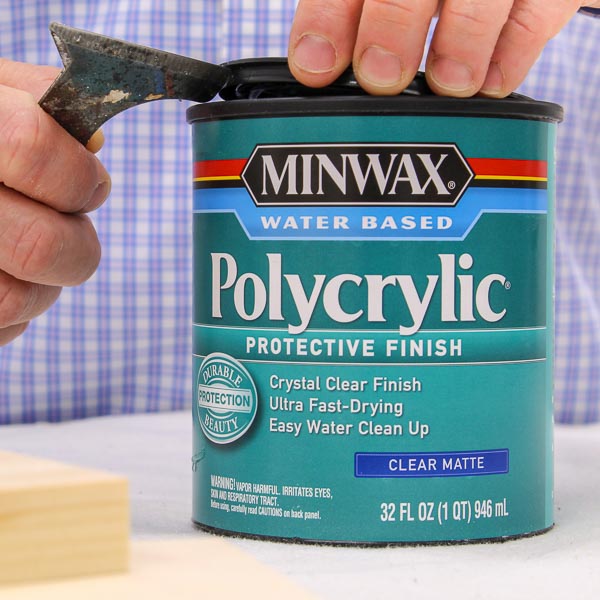Spar Urethane vs Polyurethane: Differences + Which to Use
Spar Urethane and polyurethane are two popular wood finishes. Which is better? I’ll break down the differences so you can choose the best one for your project.

What’s the difference between spar urethane and polyurethane? They both seal and protect wood, but each has specific strengths and weaknesses that make them better suited for different jobs.
Which one is the better choice for interior projects? Which can endure harsh conditions like rain, snow, and temperature changes? Find out what they have in common, how they differ, and which one is best for your project in this side-by-side comparison.
This tutorial contains affiliate links to supplies and tools. Purchases made using these links help support the Saws on Skates website and allows me to share more projects and tips with you. There is no cost to you for using these links. Visit my site policies for more information.
Table of Contents
- What is Spar Urethane?
- Types of Spar Urethane
- Where to Use Spar Urethane
- How Do You Apply Spar Urethane?
- What is Polyurethane?
- Types of Polyurethane
- Where to Use Polyurethane
- How Do You Apply Polyurethane?
- Differences Between Spar Urethane vs Polyurethane
- Spar Urethane or Polyurethane: Which is Better for Your Project?
- Safety Tips to Remember When Using Spar Urethane and Polyurethane
- Frequently Asked Questions
What Is Spar Urethane?
Spar urethane is a durable, self-leveling sealer used to protect wood. It’s a synthetic solution that contains solvents and resins like urethane plastic.
Oil-based spar urethane is the most common type, but a water-based version is also available.
Spar urethane is a transparent finish, although its high resin content gives it a somewhat yellowish tint.

Spar varnish was originally intended to preserve the spars of sailing vessels. Spars are wooden poles used in the rigging of a boat to carry or support its sail.
Spars are exposed to extreme conditions like wind, water, temperature changes, and damaging ultraviolet light from the sun. Wooden spars also expand and contract with changes in humidity and temperature.
Spar varnish was designed to withstand these harsh environments, and when dry, it remains flexible, allowing it to shrink and swell along with the movement of the wood.
Related: Mistakes with Wood Can Cause Your DIY Furniture to Crack
What Does Spar Urethane Look Like?
Spar urethane is available in several sheens. Sheen is the amount of shine or reflectivity of a coating. The higher the sheen, the shinier the finish will be.
Spar urethane is usually available in gloss (most shine), semi-gloss, and satin (least amount of shine).
Pros
- Can be used indoors or outdoors, but it’s ideal for outdoor projects
- Resistant to extreme conditions like rain, snow, and temperature swings
- Contains UV blockers to reduce fading caused by sunlight
- Can be brushed, sprayed, or wiped on
Cons
- Oil-based version has strong fumes and is combustible
- Oil-based has long drying times

Types of Spar Urethane
The most popular type of spar urethane is oil-based, although a water-based version is also available.
Oil-based spar urethane is combustible, has more fumes, and is less environmentally friendly than water-based spar urethane.
Water-based spar urethane is not combustible, has fewer fumes, is more environmentally friendly, and dries faster than oil-based spar urethane.

Where to Use Spar Urethane
Spar urethane is a durable coating that can be used to finish exterior projects like:
- Doors
- Window sashes
- Outdoor furniture
How Do You Apply Spar Urethane?
The most popular way to apply spar urethane is with a natural bristle brush. It may also be sprayed using a paint sprayer or a spray can.
It’s also possible to wipe it on with a clean rag. To wipe it on, mix 50% oil-based spar urethane with 50% mineral spirits.
Here’s a quick video showing how to apply spar urethane with a brush.
What is Polyurethane?
One of the most popular finishes used to protect interior wood projects is polyurethane. It’s a synthetic polymer, available in either oil-based or water-based formulas, that dries clear but can darken or yellow with time.
Polyurethane is a tough finish that resists chips and scratches, making it ideal for furniture, cabinets, molding, and flooring that get a lot of use.

It’s resistant to moisture, fungus, and mildew, making polyurethane an excellent choice for sealing wood that will contact water, like kitchen cabinets and bathroom vanities. It’s also resistant to oils, greases, and other chemicals.
Polyurethane is heat-resistant, making it an excellent choice for protecting furniture like kitchen and dining tables that contact hot pans and serving dishes.
Polyurethane is a hard coating that can withstand some wood movement due to seasonal changes, but it’s not as flexible as spar urethane.
Pros
- Smooth, durable, abrasion-resistant coating
- Resistant to water, fungus, and mildew
- Resistant to alcohol and other chemicals
- Resistant to heat and cold
- Can be brushed, wiped, or sprayed
Cons
- Oil-based version has strong fumes and is combustible
- Oil-based has long drying times
- Doesn’t contain UV blockers and could fade in sunlight
- Can darken or yellow with time
Types of Polyurethane
Polyurethane is sold in both oil-based and water-based versions.
Oil-based polyurethane is combustible, has more fumes, and is less environmentally friendly than water-based polyurethane.
Water-based polyurethane is not combustible, has fewer fumes, is more environmentally friendly, and dries faster than oil-based polyurethane.
Polyurethane is often confused with Minwax’s water-based Polycrylic, but there are some significant differences between these two products. Learn the differences between these two finishes in this side-by-side comparison.
Related: Polycrylic vs Polyurethane: Are They The Same?

Where to Use Polyurethane
- Floors
- Doors
- Molding
- Kitchen and dining tables
- Kitchen and bathroom cabinets
- Furniture
How Do You Apply Polyurethane
Polyurethane can be applied with a brush, sprayer, or wiped on. Liquid polyurethane should not be shaken. Shaking the container will cause bubbles to form, and the brush will pick up those bubbles and transfer them to the surface of your project. Any bubbles that form must be sanded out before the next coat is applied.
Related: How to Spray Polyurethane
Oil-based polyurethane is combustible and must be applied in a well-ventilated area away from any heat source. It’s also recommended to apply water-based polyurethane in a well-ventilated area.
When applying poly, make sure to wear a mask or respirator that’s designed to block out volatile organic compounds (VOCs).
When applying polyurethane, make sure to work in a dust-free environment. Oil-based poly can take three to four hours to dry. As a result, there’s plenty of opportunity for dust to settle on the project and dry into the finish. Before applying the next coat, any specks of dust will need to be sanded away.
Related: 11 Secrets for Sanding Wood Projects Like a Pro
For the proper amount of protection, three coats of polyurethane are generally required. The first layer or base coat of polyurethane should be thinned. A base coat is made from two (2) parts polyurethane and one (1) part paint thinner. The remaining coats are applied at full strength.
Each coat should be allowed to dry completely before applying the next coat. Polyurethane does not like to stick to itself. To provide proper adhesion for the following layer, the surface must be roughed up. Between each coat, lightly scuff the surface with 220-grit sandpaper and remove the sanding dust with a ShopVac and a tack cloth.
Related: What is a Tack Cloth? (+ What I Use Instead)

Differences Between Spar Urethane vs Polyurethane
Both spar urethane and polyurethane seal and protect wood. However, there are several significant differences between them.
The most significant difference between spar urethane and polyurethane is the amount of oil they contain and whether they’re best suited for indoor or outdoor projects.
I’ve noticed several sources claim that other differences include the drying times, application methods, and the amount of fumes they give off. But, I’ve actually found them to be comparable in these areas.
First, I’ll get into the specifics of the differences between spar urethane and polyurethane, and then I’ll go through what I believe are similarities.
Amount of Oil
Spar urethane and polyurethane contain similar ingredients, but the biggest difference between them is the ratio of those ingredients.
Oil-based spar urethane has more oil than oil-based polyurethane, which is why it’s sometimes called “long oil varnish.”
The greater concentration of oil makes spar urethane more flexible than polyurethane.
Wood expands and contracts in response to changes in humidity and temperature. Because spar urethane remains flexible when dry, it is less likely to chip or crack as a result of this movement. On the other hand, polyurethane is a harder coating that can withstand some wood movement, but it’s not as flexible as spar urethane.
The flexibility of spar urethane makes it a fantastic choice for exterior projects that experience a lot of wood movement caused by extreme humidity and temperature swings.
Indoor vs Outdoor
The original purpose of spar finish was to protect the wooden poles or spars of a sailing ship from the elements.
As a result, spar urethane is an excellent choice for protecting exterior projects. It can resist rain, snow, and significant temperature swings. It remains flexible, which allows it to expand and contract along with wood movement caused by changes in humidity and temperature. Spar urethane also has additives to help prevent sun damage and fading caused by UV rays.
Polyurethane is ideal for indoor projects. It’s a tough finish that can withstand the daily use of a kitchen table and protect a bathroom vanity against water damage. But it’s not as flexible as spar urethane and might crack or chip if used outdoors.
Polyurethane, unlike spar urethane, does not include any additives to prevent wood or wood stain from fading due to sunlight.
Drying Times
I’ve read claims that spar urethane dries faster than polyurethane, but that has not been my experience.
The directions for oil-based Minwax Helmsman spar urethane say that it can be recoated in about four hours. The directions for oil-based Minwax Fast-Drying polyurethane says that it can be recoated in three to four hours. So in my experience, the drying times are about the same for spar urethane and polyurethane.
Both water-based spar urethane and water-based polyurethane have similar drying times, but the water-based versions dry more quickly than the oil-based ones.
The slower drying times of the oil-based version means dust and debris has more time to become trapped in the finish as it dries.
Application
I’ve seen mixed opinions on the application techniques of spar urethane and polyurethane. Some claim there are differences between them, but I’ve found that they both can be brushed, wiped, or sprayed.
Applying these finishes is just like applying any finish; you must first properly prepare the surface. Prior to application, smooth the surface with sandpaper and use a tack cloth to remove any dust or debris. Otherwise, it may become trapped in the finish, or the finish won’t adhere properly.
Related: What is a Tack Cloth? (+ What I Use Instead)
Polyurethane may be purchased in quart or gallon containers, which can be applied with a brush or thinned to use with a paint sprayer. It’s also sold in a wipe-on version and in spray cans.
Related: How to Spray Polyurethane
Spar urethane is usually purchased in quart or gallon containers and applied with a brush, but it can also be thinned to use with a paint sprayer or wiped on with a clean rag. It’s also sold in spray cans.
Keep in mind if you thin spar urethane or polyurethane that you’ll need to apply more coats to get the right level of protection because it has been diluted.
Fumes
I’ve read claims that polyurethane has a stronger odor than spar urethane. Both oil-based versions are quite smelly, in my opinion.
The bigger difference is the amount of fumes between water-based and oil-based products. Water-based products have a considerably milder odor than oil-based ones.
Oil-based products have a stinky odor. Exposure to these fumes can cause dizziness, headaches, and difficulty breathing.
Oil-based finishes are also combustible. They must be applied in a well-ventilated area away from any heat source.
Water-based finishes have fewer fumes and are not combustible, but it’s still a good idea to apply them in a well-ventilated area.
Always wear the proper safety gear when applying a finish. Wear glasses to protect your eyes, a respirator to protect your lungs, and gloves to protect your hands.
Price
The costs of spar urethane and polyurethane can vary depending on the brand, but they are usually comparable. Spray cans are generally more expensive than liquid.
Back to Table of ContentsSpar Urethane or Polyurethane: Which is Better for Your Project?
Choosing between spar urethane and polyurethane is a question of whether your project will be used indoors or outdoors.
Outdoor Projects
Spar urethane can be used indoors, but it’s the better choice for exterior projects that will be exposed to wind, water, temperature changes, and sunlight.
- Spar urethane is a flexible coating that expands and contracts in response to wood movement caused by humidity and temperature changes. A harder coating like polyurethane may chip or crack under these conditions.
- Spar urethane contains additives that resist UV light, making it an excellent choice to project outdoor projects like furniture and doors.
Indoor Projects
Polyurethane is the better choice for indoor projects that won’t be exposed to temperature swings and harsh sunlight.
- Polyurethane is a durable and chip-resistant coating that is perfect for furniture, cabinetry, molding, and flooring that get a lot of usage.
- Polyurethane is resistant to heat, water, oil, grease, and other chemicals.
- Polyurethane is a strong, durable finish that can withstand some wood movement caused by seasonal changes, but it’s not as flexible as spar urethane.
Safety Tips to Remember When Using Spar Urethane and Polyurethane
- Oil-based products release fumes that can cause dizziness, headaches, and difficulty breathing. It’s recommended to apply them in a well-ventilated area.
- Oil-based finishes are combustible. They must be applied in a well-ventilated area away from any heat source.
- Water-based products have fewer fumes and are not combustible, but it’s still a good idea to apply them in a well-ventilated area.
- When applying a finish, always wear the proper safety gear. Wear goggles to protect your eyes, a respirator to protect your lungs, and gloves to protect your hands.
- Rags, towels, gloves, etc., soaked with oil-based products are combustible and should be disposed of properly.
Frequently Asked Questions
How long does stain need to dry before applying polyurethane?
It’s usually best to wait between 24 to 48 hours for the stain to dry before applying polyurethane. The polyurethane may remove some of the color if the stain isn’t completely dry. If you’re not sure whether the stain is entirely dry, wait an extra day before applying the poly.
What is spar urethane used for?
Spar urethane is a clear, protective finish used to protect outdoor wood projects like doors, window sashes, and patio furniture. It creates a moisture-resistant barrier and contains UV blockers to minimize the sun’s graying effects and maintain beauty.
Back to Table of ContentsFinal Thoughts
Spar urethane and polyurethane are both used to seal and protect wood, but each has specific strengths and weaknesses that make them better suited for different jobs. Polyurethane is an excellent choice for sealing interior projects. Spar urethane may also be used indoors, but it’s the ideal choice to protect outdoor projects against harsh conditions like rain, snow, and temperature changes.
Thank you for stopping by. If you enjoyed this tutorial, would you please take a moment and pin it to Pinterest? I’d really appreciate it!




